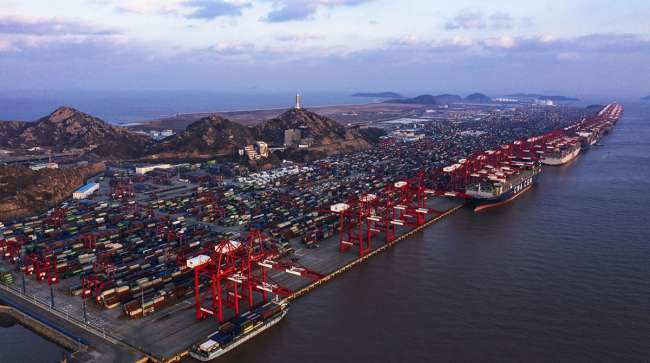Staff Reporter
FourKites Reports Chinese Ports Recovery, but Elevated US Transit Times

[Stay on top of transportation news: Get TTNews in your inbox.]
While Chinese ports are close to recovering, transit times to the United States have remained elevated, according to supply chain visibility company FourKites.
Chinese port cities returned to lockdown earlier this year in response to a re-emergence of the coronavirus. But Shanghai and some others reopened June 1. (Production delays and inland transportation bottlenecks have slowed the ramp-up of port output somewhat.)
“Now that the lockdown has been lifted, we’re seeing more shipments flow into the U.S.,” Raj Patel, vice president of third-party logistics at FourKites, told Transport Topics. “If you look at the trend, a lot of it was going to the West Coast, and getting transferred to the northeast and the Port of Savannah, which is now seeing record-high shipments. Now, we’re starting to see a lot of those shipments going back to L.A. and the West Coast ports.”

The data also shows decreased dwell times for exports while average transit times for loads remain elevated.
“The lockdown helped ease some of the inland transportation, but now that it’s open, we’re starting to see capacity get tighter, especially on the West Coast,” Patel said.
The two-week average shipment volume for loads is down 3% compared with levels the day before lockdowns began March 12. This compares with a 43% decline in April. But the percentage of shipments delayed along this lane is at 37% compared with the high of 39% seen in April.
Average transit times for loads arriving in the United States from Shanghai have remained elevated. The 60-day average transit time is now up 51% to 75.6 days compared with March 12.
Dwell times for export shipments have shown some signs of recovery. The two-week average ocean dwell time has decreased 4% to 6.5 days compared with March 12. This is also down 27% from the high seen earlier in June.
But import dwell times have remained above levels seen before the lockdown. The two-week average ocean dwell time increased 16% to 4.7 days compared to March 12.
Want more news? Listen to today's daily briefing above or go here for more info
China’s reopening of port cities had a rough start. Bottlenecks formed because of inland transportation, labor restraints and the availability of raw materials.
President Joe Biden will have to decide whether to extend a series of tariffs against China covering technology transfer, intellectual property and innovation. Former President Donald Trump imposed the tariffs, which cover roughly $370 billion in Chinese imports. Ending the tariffs could help ease inflation. But there is strong opposition to such a move from core constituencies like organized labor.
“Many tariffs imposed represent interests directly impacting individual union members,” Thomas Conway, chairman of the Labor Advisory Committee for Trade Negotiations and Trade Policy, said in a letter. “Other tariffs support the overall level of retaliation that is appropriate to respond to China’s unfair, predatory and protectionist trade policies.”

